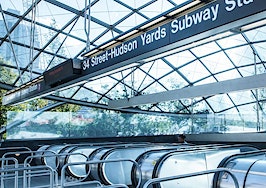- According to the NYC Department of Transportation, the number of bicyclists in the city has increased 50 percent over the last five years.
- Savvy building owners are going beyond the minimum legal requirements and installing bike storage rooms that please residents.
- There are numerous conveniences for residents by having bike storage in the building, and agents can mention it in a property listing.
Forget the subway: New Yorkers love to bike.
According to the New York City Department of Transportation, the number of bicyclists in the city has increased by 50 percent over the last five years. Miles of new bike lanes are added in the city each year, and more people are seeing biking as a healthy and fun way to get around the city or explore the great neighborhoods of NYC.
However, bicyclists have been facing one common problem: there’s little places to store a bike in their apartment.
Although residential buildings with more than 10 units constructed since 2009 are legally required to install a modest amount of bike storage, older buildings have no such requirement unless they have undergone enlargements of 50 percent or more. Residents in the majority of buildings are often frustrated by their options, which are either store their bikes in their living space or forego bike ownership altogether.

Biking is on the rise New York/Flickr user mason13a
This is why savvy building owners are going beyond the minimum legal requirements and installing bike storage rooms that please residents — ensuring the building is prepared for growth in bicycling. Although it may seem like a small detail of life, there’s quite a few benefits to sell building owners and potential residents on bike storage.
Reduce damage to lobbies, hallways and elevators
Carrying a bike up and down stairwells or squeezing it in an elevator often results in scuffs, dings and scratches to the interior of the building. By installing a secure and easy-to-access bike storage room, ideally on the ground floor, you’ll put an end to much of this damage.
Prevent installation of mounted bike racks
When a bike storage unit is not available, bicyclists will often install hooks or racks within their living area to get bikes out of the way. Designed to bear a significant amount of weight, installing these features often involves drilling several large holes into the wall or ceiling that are difficult to properly repair later.
Avoid injuries and potential lawsuits
Bikes are meant to be ridden, not carried. The risk of falls in stairwells and hallways greatly increases when trying to wrestle a bicycle through a confined space. Give residents peace of mind (and body) by not asking them to carry a bulky and heavy bike to their unit — or wiggle around those who are.
New revenue for building owners
It’s customary to charge residents for utilizing bike storage. Reasonable monthly or yearly fees quickly recover the initial investment and become a revenue generator. This is particularly true if the room is designed well, utilizing the space to efficiently and safely fit the most bikes possible.
Attract residents
As the rate of bicycling increases, bike storage will continue to become more of a priority for those looking to rent or buy in New York. If a property has a bike storage unit, make sure to include it in the listing and building tour for potential residents.
Although a bike room might be a smart investment, not all storage spaces are created equal. A room with bike racks is a good start, but adding extra touches such as repair tools and pumps will please residents. The room must also be thoughtfully designed, with adequate security measures, convenient access and storage racks arranged in a way that makes it easy and safe to move around.
Martha Burwell is a gender equity consultant in Seattle and writer for StreetAdvisor












